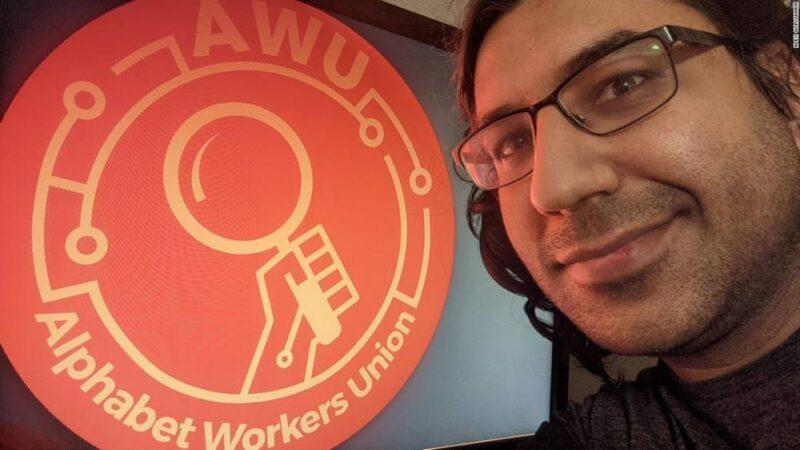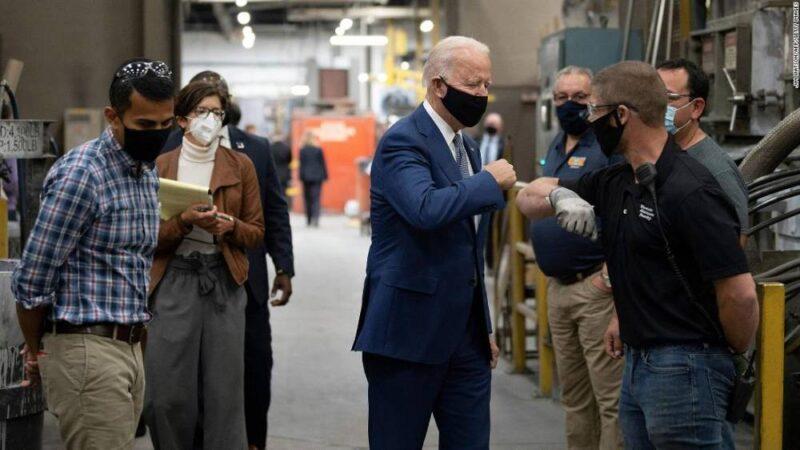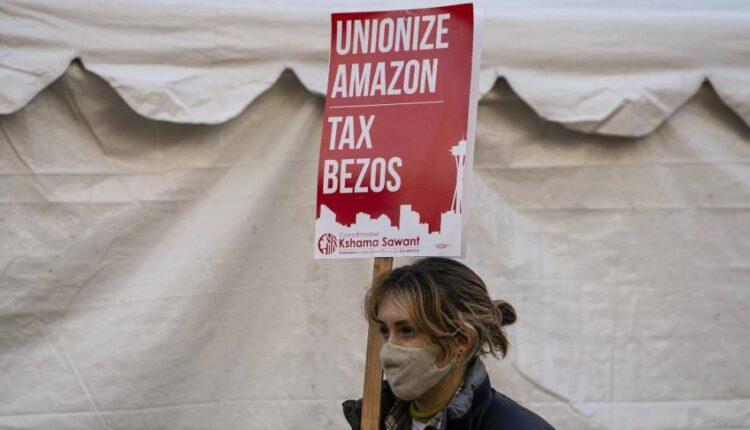Rarely has the chasm between rank-and-file-workers and the extremely wealthy been this wide. While millions of people have lost jobs, gone hungry and struggled to pay for their basic needs, billionaires’ wealth soared to new heights in 2020.
And although the pandemic made things worse, America’s wealth gap has largely been expanding since the 1980s.Among the many contributing factors: Far fewer jobholders have a seat at the table in negotiating with upper management than they did decades earlier. In 2020, union membership hit a new modern low. “There is a direct correlation that when union membership is down, economic inequality is up,” said Kent Wong, executive director of the UCLA Labor Center, a department that studies labor and economic issues.
There is a direct correlation that when union membership is down, economic inequality is up."
In cities across the US, and between the walls of some of the world’s largest enterprises, there is a swelling of union organizing activity that has been propelled by the pandemic and the recession. Read MoreFrontline workers — nurses, teachers, meatpackers, grocery-store clerks, delivery drivers and produce workers — protested for workplace protections and paid sick leave. In Big Tech, where multibillion-dollar companies have benefited from stay-at-home mandates, trailblazing unionization efforts are accelerating at Amazon and Google.And in Washington, D.C., labor just potentially gained a powerful ally in President Joe Biden, who has pledged to be “the most pro-union president you’d ever seen.”

A demonstrator holds a sign reading “Tax Bezos” during a protest outside Amazon.com headquarters in Seattle, Washington in November.”I do think that the current moment provides an opportunity for unions that has not existed in many, many years,” Wong said, “and that there is a growing national consensus that there needs to be dramatic changes to ensure that the economy does indeed work for everybody and not just Wall Street.”He added: “There is a sea change with regards to issues involving workers’ rights.”
A ‘level of desperation’
Generally, economic downturns are bad for union organizing. “For a long time, economists have argued that workers are less likely to go on strike and push for things like unions in bad economic times,” said Ileen DeVault, a professor of labor history at Cornell University’s ILR School. “Employers could fire you and replace you with another worker. Workers had more power when unemployment rates are low.”However, that hasn’t always been the case. During the Great Depression, unemployment reached as high as 25%. With the economy that bad, many workers assumed they’d likely lose their jobs anyway — so they figured they might as well come together and potentially gain protections via unionization, DeVault said. “You reach a level of desperation where that doesn’t matter as much,” she said. “I think that’s part of what we’re beginning to see today.” In fact, the Great Depression fueled the single largest union push in US history, said Wong, of the UCLA Labor Center. There are some parallels that can be drawn between then and now, when the pandemic has deepened the divide between the haves and the have-nots. In the Depression era, amid the staggering unemployment rates and the considerable economic inequality, a tremendous amount of organizing activity took place, he said, adding that a mass social movement pushed President Franklin D. Roosevelt to use the power of the federal government to improve the rights of workers.A similar phenomenon appears to be playing out now.
State of employment
The pandemic has put a spotlight on workers’ rights issues and accelerated an organizing movement that’s been slowly building in recent years — with actions such as the teachers’ strikes in 2018 and the “Fight for $15” movement, DeVault said. “For quite a while, workers have been really frustrated with not having a voice at their workplaces, and for teachers then, it just reached a breaking point,” DeVault said. “In that way, I don’t think [these efforts] are new.”What is new is that other groups of workers such as nurses, gig workers and warehouse employees are being revered as critical during the pandemic while the stark inequalities and their vulnerable situations — such as unsafe working conditions, low pay and lack of access to health care — are being exposed, said Celine McNicholas, director of government affairs and labor counsel for the Economic Policy Institute.”This is not a moment where these issues can be ignored,” she said. In 2020, nearly 14.3 million workers belonged to a union, 321,000 fewer than the year before, according to the US Bureau of Labor Statistics’ annual union membership report released Jan. 22.When the BLS started tracking the data in 1983, more than 17.7 million workers were unionized. And despite a modest uptick during the Great Recession — an increase that labor experts attribute to public-sector organizations — the levels have steadily declined to where they are at today: a historic modern low.
The outsourcing of manufacturing jobs, coupled with economic downturns, political influence, corporate actions, and the increasingly arcane and anti-union nature of the nation’s labor laws have all played a role in decreasing union density in recent decades, said labor historian Nelson Lichtenstein, a professor at the University of California – Santa Barbara, and author of the book, “State of the Union: A Century of American Labor.”A Gallup poll released in September 2020 showed that 65% of Americans surveyed were in favor of labor unions, matching a high notched in 2003 and representing a significant increase from a Great Recession-era low of 48%. “We’re looking at numbers that are so far afield from that,” McNicholas said. “That is a lot of space between workers getting what they want in a system that provides that choice in a meaningful way and a system that we have.”
From blue-collar to Big Tech
At Alphabet, the parent company to tech giant Google, a grassroots workers organization that formed without federal ratification has grown to more than 800 members since its early January launch. Called the Alphabet Workers Union, the organization seeks to provide an amplified voice for a wide swath of Alphabet employees — including full-time workers, part-timers, vendors and contractors — and create a power structure for those diverse concerns and desires to be heard. “I think that the recognition we’ve gotten from our coworkers, who have taken a real risk to join and support us, and from external forces — especially including unions and other labor movements from beyond tech — is really a validation of our underlying message: That unions are for everyone, and tech is no exception,” Alex Gorowara, a Google software engineer and Alphabet Workers Union founding member.

Alex Gorowara, a Google software engineer and one of the co-founders of the Alphabet Workers Union. In recent years, some Google employees have grown discontent over matters such as sexual misconduct allegations, lack of racial equity and the company’s business dealings.The tensions started to hit a breaking point in late 2019 when Google fired four employees who had been active in labor organizing. The National Labor Relations Board has since alleged that Google violated labor laws when firing two of those employees. Google disputes those allegations.”We strongly support the rights our employees have in the workplace, and open discussion and respectful debate have always been part of Google’s culture,” Google said in a statement. And at Amazon, a historic vote is underway at the e-commerce giant’s Bessemer, Alabama, warehouse. There, more than 5,800 employees are voting by mail as to whether they should join with the Retail, Wholesale and Department Store Union and form Amazon’s first US union. “It is not surprising that recent forces have come to lead to an organizing campaign in Amazon’s Alabama plant,” said Kenneth Dau-Schmidt, Carr Professor of Labor and Employment Law, Indiana University-Bloomington. “Amazon workers have had long-running concerns about the speed of work, safety and pay. During the pandemic, these concerns have only increased.”
The company is making money hand over fist. It is not unreasonable for the workers to expect to get higher wages and better benefits."
In addition to ongoing concerns about working conditions, especially during the pandemic, benefits have also slipped away. The company nixed a policy of unlimited time off and wound down its $2-per-hour hazard pay increase.”The company is making money hand over fist,” he said. “It is not unreasonable for the workers to expect to get higher wages and better benefits.” Amazon said it invested $2.5 billion in employee bonuses and incentives during 2020 atop its $15 minimum wage. And at the Bessemer site, which opened in March, the company created thousands of full-time jobs that start at $15.30 per hour and include a variety of benefits, Amazon spokesperson Heather Knox said in an emailed statement. “We don’t believe the RWDSU represents the majority of our employees’ views,” Knox said. “Our employees choose to work at Amazon because we offer some of the best jobs available everywhere we hire, and we encourage anyone to compare our total compensation package, health benefits, and workplace environment to any other company with similar jobs.” If successful, the Amazon employees would join a new batch of collective organizations at places such as cannabis companies and media organizations like Gawker, Buzzfeed, Vice, Vox and the New Yorker. The evolution from blue-collar card holder to unionized budtenders and journalists serve as a reflection of how industry in America has changed during the past century.
‘People were scared that they would be fired’
Recent unionization rumblings are not unique to Big Tech or media. Industries at the frontlines of the pandemic — like teaching and nursing — have also picked up organizing activity in the last year.

Members of the National Nurses United stand in protest across from the White House, seeking workplaces protections. The empty shoes represent nurses that they say have died from Covid-19. In late 2019, Kerri Wilson sat in a room with about a dozen fellow nurses as they discussed unionizing at their Mission Hospital in Asheville, North Carolina. Earlier that year, HCA Healthcare (HCA), a hospital conglomerate based in Nashville, had acquired Mission Hospital, and in the months that followed, operational and staffing cutbacks drew public outrage from nurses, patients and lawmakers, the Asheville Citizen-Times reported.Privately, the nurses explored organizing. “A lot of folks were resistant in the beginning — more out of fear,” Wilson said in an interview with CNN Business. “We’re in the South, and unions aren’t much of a thing here. And people were scared that they would be fired.”Wilson, 34, has been a nurse for eight years, five of those at Mission Hospital. She works in the cardiology unit, serving high-acuity patients. The Asheville native was drawn to her hometown hospital as it often landed on many top state and national hospital rankings — especially for cardiology care.”I want to be able to take care of my patients the way they deserve,” she said. But when the pandemic hit, nurses felt like the conditions deteriorated, and personal protection equipment was in short supply, she said, adding that the situation emboldened those who sought to organize. (A Mission Health hospital spokesperson said HCA Healthcare acted very early on at its hospitals to provide equipment, conduct screenings, assign stewards to ensure proper PPE use and fitting, and add nurses.)After a monthslong campaign, nurses at Mission Hospital voted to unionize in September 2020. National Nurses United, one of the nation’s largest unions that now represents Mission Hospital nurses, described the organization of about 1,800 nurses at Mission Hospital as the largest hospital unionization in the South since 1975.And it’s not just happening in Asheville: During the Covid-19 pandemic, nurses throughout the country have contacted National Nurses United at a significantly higher rate than before, said Zenei Triunfo-Cortez, a Bay Area registered nurse and president of National Nurses United.”They saw that we were advocating for nurses’ welfare, we were advocating for our patients’ welfare,” she said. “They wanted to join an organization that did just that.”
A potential ally in the White House
A day before the 2020 election, Joe Biden told a crowd of union members in Beaver County, Pennsylvania, that he’d be “the most pro-union president you’ve ever seen.”The Scranton, Pennsylvania, native has long garnered support from working-class Americans, but after four years of “fierce anti-union, anti-worker policies” enacted during the Trump administration, labor unions mobilized behind Biden in key battleground states such as Michigan, Pennsylvania and Wisconsin, UCLA’s Wong said. “These were the people who got Joe Biden elected,” he said.

On the campaign trail Joe Biden visited with union members in an aluminum factory in Manitowoc, Wisconsin in September.Biden’s pro-union campaign plan included forming a cabinet-level working group in the first 100 days of the presidency to increase union density. Biden also promised to require federal contractors to sign neutrality agreements committing to not run anti-union campaigns. Depending on how it’s written, such a policy could have a ripple effect on Big Tech, which has resisted unionization efforts in the past. Companies like Amazon, Google and Microsoft contract with the federal government. A White House spokesperson declined to comment on specific details or a timeline for when Biden might enact that policy. In early February, he tweeted, “The policy of our government is to encourage union organizing, and employers should ensure their workers have a free and fair choice to join a union.” (That said, Biden has yet to comment publicly on the unionization effort underway at Amazon — rankling some union supporters.)
Every American deserves the dignity and respect that comes with the right to union organize and collectively bargain. The policy of our government is to encourage union organizing, and employers should ensure their workers have a free and fair choice to join a union.
— President Biden (@POTUS) February 4, 2021 In the early days of the new presidency, Biden signed an executive order that restored collective bargaining power to federal employees, and the administration took aim at the National Labor Relations Board, ousting Trump-appointed officials such as Peter Robb, the board’s general counsel. Robb, a longtime management-side lawyer, most notably served as the lead attorney in the Reagan Administration’s watershed case that decertified the Professional Air Traffic Controllers Organization in 1981. (The Reagan administration’s firing of more than 11,300 striking air traffic controllers and the subsequent PATCO takedown have been viewed as catalysts for a decline in union activity.)Biden on February 17 nominated Jennifer Abruzzo, the Communication Workers of America’s special counsel for strategic initiatives, to replace Robb.Labor advocates are viewing these actions and other nods — including Biden tapping Marty Walsh, the Boston mayor and former union leader, as labor secretary; and Biden having a bust of labor leader Cesar Chavez behind the Resolute Desk in the Oval Office — as signs that their causes will be championed.”It’s not just an election campaign promise,” said Triunfo-Cortez, of National Nurses United, which received the backing of Biden and his wife, Jill, during the Mission Hospital unionization. “It gives us a lot of renewed hope for union organizing.”
Consequential legislation
But just how much the Biden administration can accomplish beyond executive action and rulemaking remains to be seen. “I think without major changes in the law, you’re not going to see large increases in union organizing into the future,” Dau-Schmidt said. One legislative vehicle in the wings is the union-friendly Protecting the Right to Organize (PRO) Act, which was reintroduced by Democrats earlier this month. The bill includes a slew of provisions that proponents say will make it easier for workers to form unions, conduct strikes, and bargain for better wages and working conditions. The PRO Act could significantly upend current labor law by allowing for actions such as NLRB-levied fines and potential civil penalties for labor rights violations; the weakening of states’ “right-to-work” laws, which say workers cannot be compelled to join a union as a requirement of their job; and -— consequential to the freelance and gig economies — the implementation of an “ABC” test for determining if a person is an employee or contract worker.That said, that bill and other large legislative vehicles might not be filibuster-proof, said the EPI’s McNicholas. “I don’t know that it is completely unpassable, but I think that getting to the 60 [votes required in the Senate] is obviously a heavy lift,” she said. That’s not to mention the considerable opposition from business executives, shareholders and a host of organizations such as the National Retail Federation, the National Federation of Independent Businesses, the American Society of Journalists and Authors, and the US Chamber of Commerce. The Chamber, which has campaigned against the PRO Act since when it was first introduced in 2018, described it as a “grab-bag of harmful policies.””This legislation strips workers of their privacy, threatens private ballots, imposes California’s disastrous independent contractor test, jeopardizes employers’ right to free speech, and threatens the loss of a job should workers choose not to pay union dues,” Glenn Spencer, the Chamber’s senior vice president of employment policy, said in a statement posted earlier this month. He added: “This bill is a threat to America’s workers, employers, and our economy.” Biden also has expressed support for legislation such as the Fairness to Farm Workers Act and Domestic Workers’ Bill of Rights, which advocates say would expand federal protections to agricultural and domestic workers. These types of workers often don’t have a collective or a firm to bargain with, said Ai-jen Poo, who helms the National Domestic Workers Alliance, a non-union organization that advocates for home care workers, nannies, house cleaners and other domestic-centric employees.
“We are witnessing a full-blown depression within our workforce, with people struggling to survive; I know this is true throughout the economy,” she wrote via email to CNN Business. “Workers must be a part of shaping our recovery, or we risk even greater inequality and fragility in our economy coming out of this crisis.”
Source: edition.cnn.com

